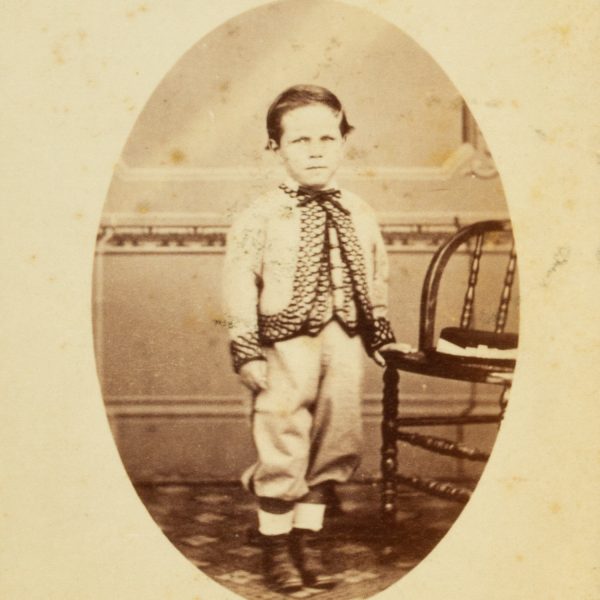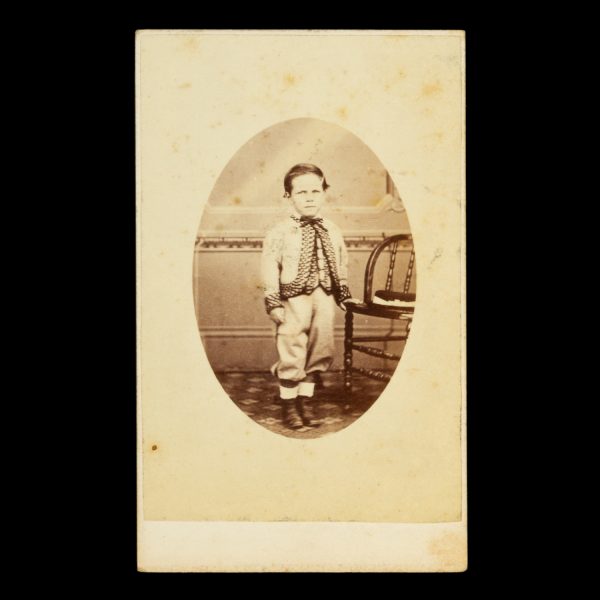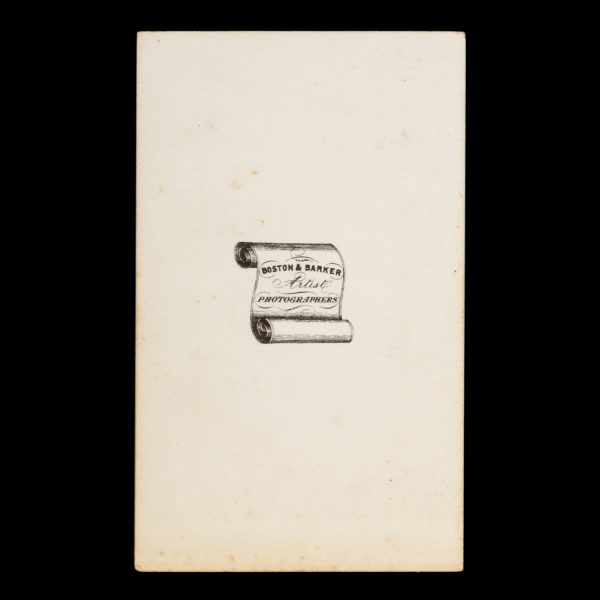# 39461
BOSTON & BARKER
Studio portrait of a young boy wearing an embroidered jacket. Yass (or Burrowa, or Young), New South Wales, 1868 or 1869.
$165.00 AUD
Albumen print photograph, carte de visite format, 104 x 63 mm (mount); verso with the imprint of ‘Boston & Barker, Artist Photographers’; some scattered light foxing, else very good condition; the mount is clean and stable.
A rare example of a carte de visite studio portrait taken by travelling professional photographers who were only briefly active in the Yass-Burrowa-Young district, between August 1868 and May 1869.
The photographic firm of Boston & Barker is not listed in Davies & Stanbury (The Mechanical Eye in Australia). There can be little doubt, however, that the Boston in this partnership refers to Thomas Boston, a professional photographer who had been operating in Newtown in Sydney, and who would later work in the Hawkesbury district at Windsor. The identity of Barker is a mystery – perhaps he was an artist specialised in colouring photographs, rather than a photographer. The pair arrived in Yass, on the Southern Tablelands of New South Wales, from Sydney in the winter of 1868, and opened a studio there. From The Yass Courier, 12 August 1868:
‘BOSTON & BARKER Artist Photographers, HAVE ARRIVED from SYDNEY, and will open their GALLERY IN YASS in a few days, for the purpose of taking PORTRAITS in every style of the art. Cartes de Visite, plain or coloured ; Glass Portraits of various descriptions ; Minatures in Brooches or Lockets ; Views of Residences, &c., taken by them will be finished in a style which must ensure entire satisfaction, MESSRS BOSTON & BARKER wish to mention that they will be prepared to take FAMILY GROUPS in sizes suitable for framing ; also, CABINET PORTRAITS, having purchased from Melbourne a superior set of lenses specially adapted for that purpose. SPECIMENS will shortly be on view at their Gallery, the entrance to which is by the private door to the Yass Hotel, next to Mr Jackson’s, Saddler.’
However, it appears that while Boston and Barker did establish a semi-permanent studio (or ‘gallery’) in Cooma Street, Yass, their business plan entailed travelling throughout the district and making short stays in various townships where they would advertise their temporary services in the local newspaper. This is borne out by the wording of the following notice in The Yass Courier on 29 August 1868:
‘BOSTON & BARKER ARE now taking PORTRAITS in every style, at their GALLERY, Cooma-street. Intending visitors are requested to make an early call, as their stay is limited. CARTES DE VISITE, 4 for 10s. ; additional copies. 1s. 6d. each. Coloured Portraits in case, complete, from 3s. An inspection of specimens taken in Yass is invited.’
On 16 January 1869, Boston & Barker closed their Yass studio altogether and travelled north to nearby Burrowa (Boorowa), where they set about establishing another gallery (The Yass Courier, 19 January 1869).
The firm’s peripatetic activity is well illustrated in this notice which appeared in The Burrangong Argus, 10 April 1869, during their short visit to Young, situated to the west of Boorowa:
‘PHOTOGRAPHY.—Messrs. Boston and Barker, who have been located opposite the Empire Hotel during the past six or seven weeks, have requested us to state they will be leaving Young immediately after the races. Those who have not yet availed themselves of the opportunity afforded by the visit of these artists should, therefore, do so before they leave.‘
By May 1869 the partnership was back working in Burrowa again. A notice to this effect in The Yass Courier, 18 May 1869, is, however, the last mention of the firm’s activity. We assume that the partnership was dissolved around this date, and that Boston, at least, returned to Sydney.
We are inclined to believe that the lovely oval format portrait of a young boy we offer here was taken in Boston & Barker’s principal Yass establishment, in 1868. However, it could certainly have been taken in one of the firm’s other ‘galleries’ – in Boorawa or Young, for example – since the painted architectural interior back drop, studio carpet and chair were all portable items that could have been easily transported through the countryside in the covered wagon which would have carried the firm’s photographic equipment.








